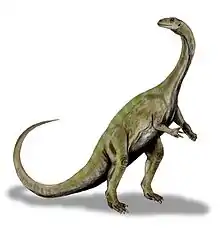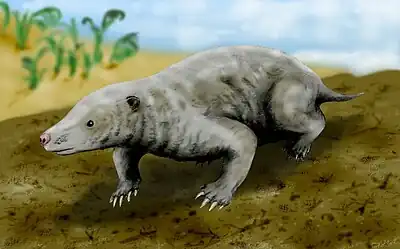IntroductionThe Mesozoic Portal.jpg.webp) The Mesozoic Era is the second-to-last era of Earth's geological history, lasting from about 252 to 66 million years ago, comprising the Triassic, Jurassic and Cretaceous Periods. It is characterized by the dominance of archosaurian reptiles, such as the dinosaurs; an abundance of gymnosperms, (such as ginkgoales, bennettitales) and ferns; a hot greenhouse climate; and the tectonic break-up of Pangaea. The Mesozoic is the middle of the three eras since complex life evolved: the Paleozoic, the Mesozoic, and the Cenozoic. The era began in the wake of the Permian–Triassic extinction event, the largest well-documented mass extinction in Earth's history, and ended with the Cretaceous–Paleogene extinction event, another mass extinction whose victims included the non-avian dinosaurs, pterosaurs, mosasaurs, and plesiosaurs. The Mesozoic was a time of significant tectonic, climatic, and evolutionary activity. The era witnessed the gradual rifting of the supercontinent Pangaea into separate landmasses that would move into their current positions during the next era. The climate of the Mesozoic was varied, alternating between warming and cooling periods. Overall, however, the Earth was hotter than it is today. Dinosaurs first appeared in the Mid-Triassic, and became the dominant terrestrial vertebrates in the Late Triassic or Early Jurassic, occupying this position for about 150 or 135 million years until their demise at the end of the Cretaceous. Archaic birds appeared in the Jurassic, having evolved from a branch of theropod dinosaurs, then true toothless birds appeared in the Cretaceous. The first mammals also appeared during the Mesozoic, but would remain small—less than 15 kg (33 lb)—until the Cenozoic. The flowering plants appeared in the early Cretaceous Period and would rapidly diversify throughout the end of the era, replacing conifers and other gymnosperms as the dominant group of plants. (Full article...) Selected article on the Mesozoic world and its legacies Artist's restoration of Massospondylus carinatus. The type species is M. carinatus; seven other species have been named during the past 150 years, but only M. kaalae among these is still considered valid. Prosauropod systematics have undergone numerous revisions during the last several years, and many scientists disagree where exactly Massospondylus lies on the dinosaur evolutionary tree. The family name Massospondylidae was once coined for the genus, but because knowledge of prosauropod relationships is in a state of flux, it is unclear which other dinosaurs—if any—belong in a natural grouping of massospondylids. Although Massospondylus was long depicted as quadrupedal, a 2007 study found it to be bipedal. It was probably a plant eater (herbivore), although it is speculated that the prosauropods may have been omnivorous. This animal, 4–6 metres (13–20 ft) long, had a long neck and tail, with a small head and slender body. On each of its forefeet, it bore a sharp thumb claw that was used in defense or feeding. Recent studies indicate Massospondylus grew steadily throughout its lifespan, possessed air sacs similar to those of birds, and may have cared for its young. (see more...) Selected article on the Mesozoic in human science, culture and economicsIn 1958, Lebanese speleologists discovered the upper galleries 60 metres (200 ft) above the lower cave which have been accommodated with an access tunnel and a series of walkways to enable tourists safe access without disturbing the natural landscape. The upper galleries house the world's largest known stalactite. The galleries are composed of a series of chambers the largest of which peaks at a height of 120 metres (390 ft). Aside from being a Lebanese national symbol and a top tourist destination, the Jeita grotto plays an important social, economic and cultural role and is a finalist in the New 7 Wonders of Nature competition, and as of 7:44 pm GMT the provisional New7Wonders of Nature based on the first count of vote results on 11/11/11 Jeita was one of the top 14 Finalists in the New7Wonders of Nature. (see more...) Selected image
Did you know?Life restoration of Laellynasaura.
Related portalsTopicsGeochronology - Triassic (Early - Middle - Late) - Jurassic (Early - Middle - Late) - Cretaceous (Early - Late) Mesozoic landmasses - Pangaea - Gondwana - Laurasia - Africa - North America - South America - Antarctica - Asia - Australia - Europe - Appalachia - Laramidia Major Mesozoic events - Mesozoic Marine Revolution - Carnian Pluvial Event - Triassic-Jurassic extinction event - Toarcian turnover - Cretaceous Terrestrial Revolution - Western Interior Seaway anoxia - Chicxulub impact - Cretaceous-Paleogene extinction event Triassic biota appearances - Belemnites - Crickets - Dinosaurs - Earwigs - Ichthyosauromorphs - Pseudosuchians - Pterosaurs - Sauropterygians - Testudinates Jurassic biota appearances - Ammonitids - Ankylosaurs - Avialans - Caecilians - Carnosaurs - Caudates - Ceratopsians - Ceratosaurs - Coelurosaurs - Cryptodires - Dromaeosaurids - Equisetum - Frogs - Horse-flies - Lepidopterans - Lizards - Mammals - Ornithopods - Pterodactyloids - Sauropods - Snakeflies - Stegosaurs - Tyrannosauroids Cretaceous biota appearances - Abalones - Anglerfishes - Ants - Bees - Catfishes - Copepods - Cormorants - Crocodilians - Flowering plants - Fowls - Geckos - Hadrosauroids - Hermit crabs - Lobsters - Mosasaurs - Ornithomimosaurs - Oviraptorosaurs - Pachycephalosaurs - Requiem sharks - Sea turtles - Snakes - Squids - Stingrays - Therizinosaurs Fossil sites - Berlin–Ichthyosaur State Park - Petrified Forest National Park - Dinosaur National Monument - Dinosaur Valley State Park Stratigraphic units - Chinle Formation - Elliot Formation - Ischigualasto Formation - Kimmeridge Clay - Morrison Formation - Oxford Clay Formation - Solnhofen lithographic limestone - Tendaguru Formation - Crato Formation - Dinosaur Park Formation - Djadochta Formation - Hell Creek Formation - Niobrara Formation - Two Medicine Formation - Wessex Formation - Yixian Formation History - History of paleontology - Timeline of paleontology - Timeline of ankylosaur research - Timeline of ceratopsian research - Timeline of ceratosaur research - Timeline of dromaeosaurid research - Timeline of hadrosaur research - Timeline of ichthyosaur research - Timeline of plesiosaur research - Timeline of stegosaur research - Timeline of tyrannosaur research Researchers - William Buckland - Edward Drinker Cope - Jack Horner - Othniel Charles Marsh - Gideon Algernon Mantell - John Ostrom - Sir Richard Owen - Harry Govier Seeley - Samuel Wendell Williston Culture - Treatise on Invertebrate Paleontology - Vertebrate Paleontology - Walking with Dinosaurs - Jurassic Park Quality ContentFeatured Mesozoic articles - Bone Sharps, Cowboys, and Thunder Lizards - Bone Wars - Edward Drinker Cope - Geology of the Capitol Reef area - Geology of the Death Valley area -Geology of the Grand Canyon area - Geology of the Zion and Kolob canyons area Good Mesozoic articles - Chitinozoan - Coal ball - Dimetrodon - History of paleontology - Evolutionary history of life - Ornatifilum - Opabinia - Paleontology- Schinderhannes - Small shelly fauna - Temnospondyli - Tiktaalik - Waptia Subcategories Mesozoic Mesozoic by continent Mesozoic geochronology Mesozoic events Fiction set in the Mesozoic Mesozoic geology Mesozoic life Mesozoic paleogeography Mesozoic paleontological sites Mesozoic portals Mesozoic stubs Things you can do
Need help?Do you have a question about Mesozoic that you can't find the answer to? Consider asking it at the Wikipedia reference desk. Associated WikimediaThe following Wikimedia Foundation sister projects provide more on this subject:
Discover Wikipedia using portals
|

